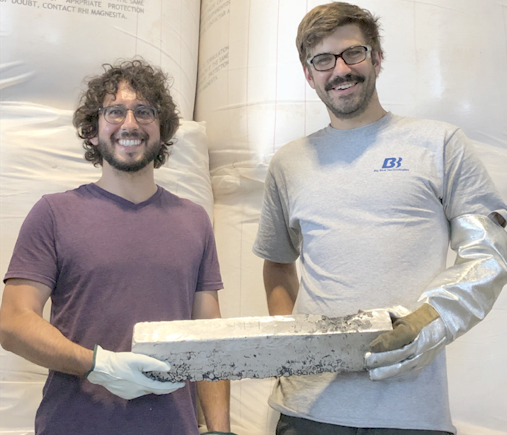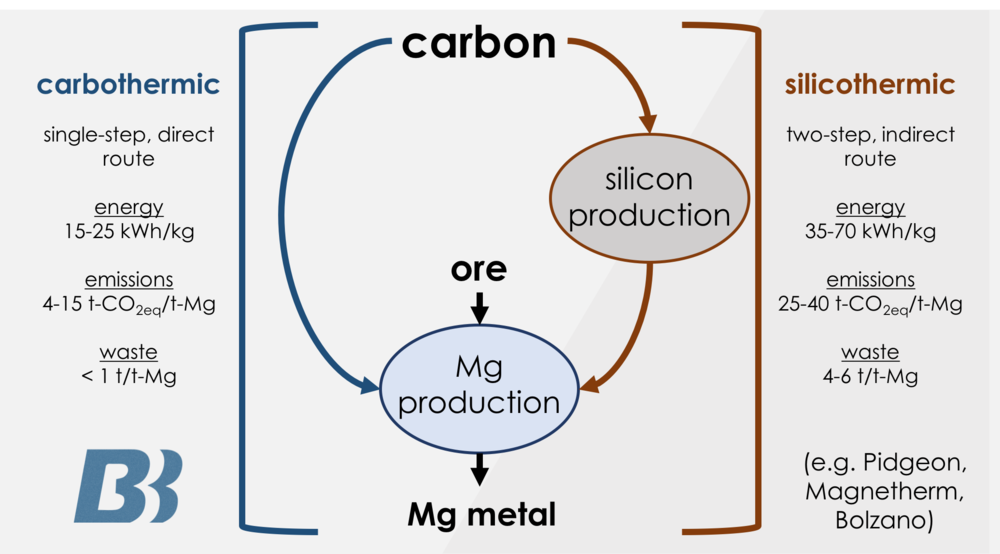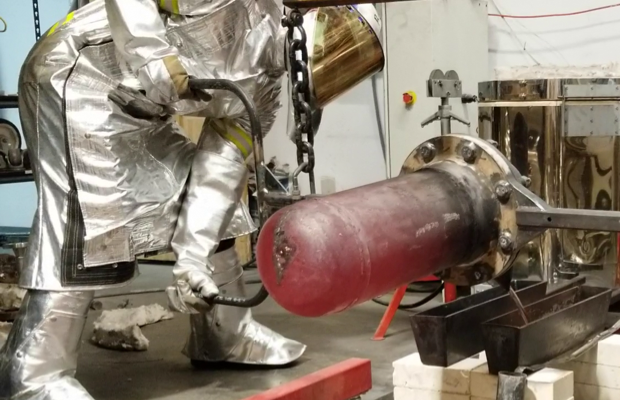
Big Blue Technologies has officially begun producing primary magnesium (Mg) metal on its pilot system in Denver, Colorado (Figure 1), which uses a proprietary carbothermal reduction process. Implementing modern high temperature and vacuum engineering solutions, the company aims to introduce the world’s most energy and material efficient primary production process. The company plans to produce magnesium ingots, granules, powders, and alloys in order to accelerate the use and application of magnesium metal.
Big Blue Technologies was spun-off from the University of Colorado at Boulder and a $4 million research project funded by the U.S. Department of Energy’s Advanced Renewable Energy Projects Agency (ARPA-E). Using non-dilutive development funding from the National Science Foundation and the State of Colorado’s Office of Economic Development, Big Blue Technologies has now scaled their process by over one thousand times to a system capable of production rates near 2 kg/hr.
The Carbothermal Reduction Process
About 85% of the world’s magnesium is currently made in China using an indirect route known as the Pidgeon process. Pidgeon is a silicothermic process pathway that requires the use of ferrosilicon. Ferrosilicon is produced by heating carbon with silica and iron, thus requiring two major steps. It also has a high energy and labor burden, making it expensive to implement outside of China.
By comparison, the carbothermal reduction process is conceptually more simple, uses less energy intensive, and has fewer steps (Figure 2). In the carbothermal reduction process, carbon is used to reduce magnesium oxide to produce magnesium metal vapor and the byproduct carbon monoxide gas at temperatures above 1,600°C.

To create an ingot, this gas must be cooled to condense the Mg. Historically, this chemistry has been difficult to implement because, during the condensation process, some of the Mg would oxidize and form impure powders. These powders presented extreme handling risks and required enormous effort to purify and form into bulk ingot.
Fundamental research at the University of Colorado at Boulder helped develop a method to minimize oxidation. The process (which Big Blue Technologies is implementing) is able to capture the gaseous magnesium by condensing it onto a recycled medium, which enables the safe recovery of magnesium for the production of ingots with less effort (Figure 3). The company has also focused on material handling, preventing the formation of pyrophoric fines, and refining — all equally important aspects of the production process.

“Incorporating [a recycled medium], we can sustain an overall magnesium oxide-to-ingot recovery of over 91%, driving our economic value proposition,” said Dr. Boris Chubukov, chief technology officer for Big Blue Technologies.
In addition to being more efficient than the Pidgeon process, the company’s carbothermic reduction method is more environmentally friendly. If renewable energy sources supply all of the electricity to the plant, the company reports total process emissions less than 2 kg CO2/kg Mg, starting with magnesium oxide and forming pure magnesium ingots. Depending on the originating sources of magnesium oxide, electricity, and carbon (the three major inputs to the process), Big Blue Technologies reports total process emissions between 0.5–12 kg CO2/kg Mg.
“We can be near net zero with our process,” said Dr. Aaron Palumbo, CEO of Big Blue Technologies. “But this comes with an extra cost, and the market does not appear to be receptive to paying a premium for green magnesium. Regardless, our technology is future-proof with respect to environmental impact. We generate very little waste, don’t use any process water, and can eliminate all emissions. But these advantages must also support cost-competitiveness in a one-sided industry.”
Unlike most other magnesium producers in the industry, Big Blue Technologies is not tied to any specific ore deposit. Because of this, the company sources magnesium oxide on the open market from various ore deposits around the world, including sea water, brucite, and magnesite deposits. They address their opportunity as a matter of technological achievement, rather than a traditional mining project, lending flexibility to how and where the technology is implemented.
“Making metal is the easy part. We’ve been doing that for the past six years,” said Chubukov. “Developing and scaling a process technology that can go head-to-head with Chinese domination of the industry, that’s the real de-risking challenge and opportunity.”
Scaling Up
With the pilot system officially in operation, the Big Blue Technologies team is continuing to iterate on the design and operation, working toward increasing efficiency, and de-risking its plans for commercial scale-up.
“Historical deployments of magnesium plants all over the world have provided a rich context for ensuring our scale-up strategy is safe and attuned to market conditions and potential geo-political trade shifts,” said Palumbo. “Our process is simple, flexible, and easily scaled to accommodate growth while tempering market volatility. Our business case is not just about significantly reducing environmental impact, which we do, but ensuring our cost-competitive technology can help anchor our domestic manufacturing industries.”
The next step for Big Blue Technologies is to establish a modular demonstration unit with volume production. In collaboration with their partners, the company has begun this effort at a facility near Cheyenne, Wyoming, while maintaining their headquarters, R&D, and pilot operations in Denver.
